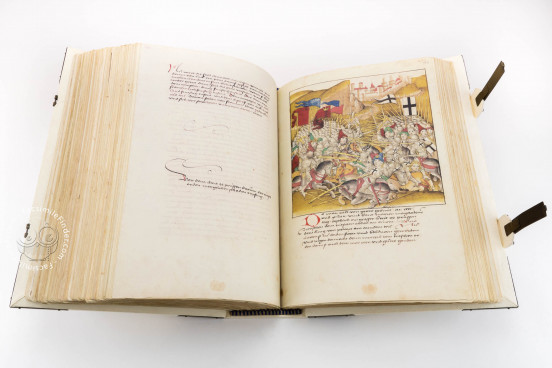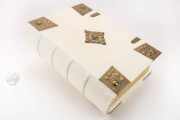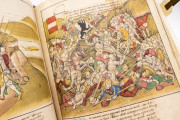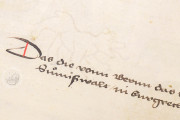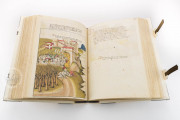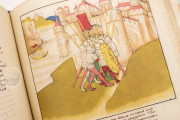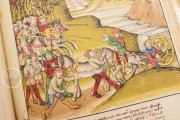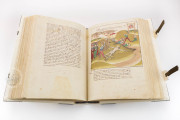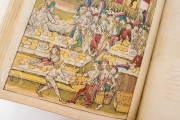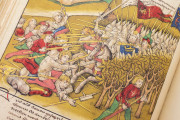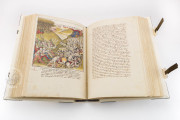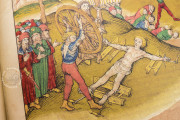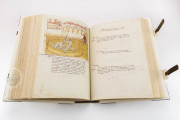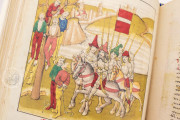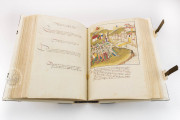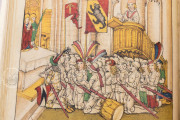The Spiez Chronicle of Diebold Schilling is a richly illuminated manuscript chronicle of the Swiss city of Bern produced in the late fifteenth century in Bern. It includes 339 large miniatures, elegant initials, and detailed animal illustrations. Commissioned by Rudolf von Erlach, a Bern nobleman, the manuscript celebrates both Bern’s history and the legacy of the Erlach family. It is Schilling’s final and most artistically significant work and exemplifies the craftsmanship of medieval scribes and illuminators while providing insight into manuscript production and the historical context of the era.
The Spiez Chronicle stands as the final work produced within the distinguished tradition of fifteenth-century Bernese historiography. Diebold Schilling maintained particularly close relations with the Erlach family—his wife Katharina even served as godmother to one of Rudolf's sons.
Diebold Schilling's Chronicles: Masterpieces of Medieval Swiss Historiography
Three exceptional illuminated chronicles by Diebold Schilling have survived to the present day: the Great Burgundian Chronicle (also known as the Zürcher Schilling), which documents the conflict between the Swiss Confederation and Charles the Bold; the three-volume Official Bern Chronicle; and the Spiez Chronicle, commissioned by Rudolf von Erlach, Mayor of Bern, which represents the pinnacle of Schilling's artistic achievement.
Rudolf von Erlach was eager to possess his own version of Schilling's chronicles. The resulting Spiez Chronicle would become Schilling's final work before his death in 1486. Its exceptional illustrations distinguish it as the most valuable and aesthetically significant work in Schilling's entire artistic corpus.
Rudolf von Erlach: Nobleman and Councilor
Rudolf von Erlach commissioned his private chronicle at the zenith of his political career, when he ranked among the most influential members of the Bern Council. His family claimed a distinguished lineage as high-ranking officials who had served under the Counts of Nidau.
Born in 1448, Rudolf aligned himself with his father's hometown of Bern during the Burgundian conflict, despite holding several feudal estates in Burgundy. His political ascent was swift, culminating in a position at the apex of the city's administration.
The chronicle he commissioned reflects both the pride in his family's illustrious heritage and his self-assurance as a Bernese statesman, while simultaneously expressing Rudolf von Erlach's personal worldview and lifestyle.
The Culmination of a Chronicler's Career
When Diebold Schilling presented his three-volume Official Chronicle of Bern to the Bern Council at Christmas 1483, he likely inspired Rudolf von Erlach's desire to possess such a magnificent work.
Rudolf commissioned his chronicle shortly thereafter. Schilling executed the text in the same meticulous handwriting he had employed in previous works. Across 806 pages featuring 344 illustrations, he chronicled the history of Bern from its foundation through 1465.
Several minor textual abbreviations toward the conclusion reveal the chronicler's growing urgency: due to his advanced age and declining health, Schilling needed to complete the work expeditiously.
A Visual Masterpiece of 344 Compositions
The extraordinary pictorial elements of Schilling's final illuminated chronicle elevate it to the summit of his historiographical achievement. The lifelike pen drawings, enhanced with numerous shades of azure, surpass the artistic quality of earlier illuminated chronicles.
These illustrations demonstrate the artist's remarkable compositional skill in orchestrating primary and secondary narrative elements and establishing coherent relationships between foreground and background scenes.
Schilling frequently incorporates captivating glimpses of distant landscapes through background "windows," providing lyrical counterpoints to the dramatic foreground events.
As with the text, the illustrations predominantly feature battle scenes. The artist positions his protagonists centrally, often depicted as opposing groups. The proportions and postures of the figures showcase Schilling's exceptional ability to render human physiology with precision and nuance.
The chronicle's decoration was specifically tailored to Rudolf von Erlach's requirements, designed to commemorate and celebrate his family's honor and achievements for posterity.
We have 1 facsimile edition of the manuscript "Spiez Chronicle of Diebold Schilling": Diebold Schillings Spiezer Bilderchronik facsimile edition, published by Faksimile Verlag, 1990
Request Info / Price
